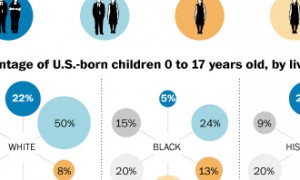
When thinking about the typical U.S. family, you might imagine a classic sitcom like The Brady Bunch: stay-at-home mom Carol, architect husband Mike, and six lovely children. At the time the show aired, a “blended” family of remarried adults was a bit of a novelty, sure, but it still stuck to the married mother and father, father is the breadwinner trope. And that’s still how many often picture U.S. families.
The Washington Post reports the findings of Ohio State University’s Department of Sociology on the living arrangements of U.S. children from birth to 17 years old. The researchers found that the children’s living arrangements varied distinctly by race. Asian children were most likely to live with a married mother and father, with only the father working, but that set-up only counted for 24% of living arrangements among Asian children. It turns out that dual-income households are the strong majority among both white and Asian children, and that both are more likely to live in dual-income households than either black or Hispanic children. Higher percentages of black and Hispanic children are living with their grandparents. Another notable statistic among black children is their greater likelihood of living with a single, never-married mother (this is true for nearly a quarter of all black kids).
No word yet on all white, three-boy, three-girl families with maids.

Comments 4
John — September 22, 2013
As interesting as it would have been to see a black father with his three black sons marry a white woman with her three white (and blonde) daughters, Wayne Brady was not on the Brady Bunch. The father's name was Mike Brady.
Kat Albrecht — September 22, 2013
Duly noted and corrected, Thanks John!
Keith Rosenthal — September 25, 2013
Why do you follow this crap! Think outside of the box as to the many combinations of parents that exist.
Friday Roundup: September 27, 2013 » The Editors' Desk — September 27, 2013
[...] Unique Families: Not So Unique on Citings and Sightings [...]